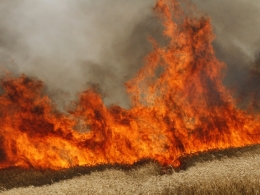
Now that harvest 2017 is coming to an end many farmers will be feeling relieved as all their hard work has been rewarded. The crops have been harvested, the straw has been baled and the combine is soon to be put away till next year. However, it doesn’t stop there. With an increase in organic materials now in storage on the farm, there is an increased fire risk.
In 2016, we had over 150 fire claims at Rural, accounting for 5% of our overall claims but costing over £3million. So although the number of claims is relatively low, the financial impact when an incident occurs can come at a huge cost to your business. That’s why as harvest draws to a close it’s important to ask yourself the following questions.
1. Have you checked what’s covered under your farm combined insurance policy?
Our claims manager Mark Jones acknowledges that being underinsured is often an issue with fire related claims, that’s why it’s important to review your agricultural insurance policy to check your sums insured. Different insurers will have specific conditions that you’ll need to adhere to. For example, at Rural Insurance the maximum value of any one stack must not exceed £25,000 and there can be no more than 5 stacks in any one location.
2. Have you stored your stacks of hay and straw appropriately?
To avoid spontaneous combustion bales should be stacked when dry otherwise the temperature of the stacks will need monitoring on a daily basis. Stacks should be spaced apart to reduce the risk of the fire spreading. At Rural if a stack is stored outdoors the distance between the stacks should be more than 50 metres (or 15 metres if the stacks are stored in separate buildings).
3. Have you removed all your hay and straw from the field after harvesting?
Bales that are left in isolated areas can become a key target for arson attacks so make sure that once you’ve baled your crops you remove them from your field. In recent months Farmers Weekly have reported 2 arson attacks; one for 1,500 straw bales in Oxfordshire and the other for 1,000 bales destined for a biomass power station in North Lincolnshire.
4. Is the storage of petrol, diesel, and chemicals clearly labelled and stored away from other farm buildings?
A fire ignites when 3 elements are present; heat, fuel and oxygen so by keeping the storage of fuel and chemicals separate to other buildings fires can be prevented. You should also consider padlocking storage tanks for added security.
5. Are you using equipment near combustible material?
It might seem obvious but don’t use equipment such as an angle grinder in a barn full of hay. Believe it or not this is an example of a claim from a Rural customer. Make sure you consider your working environment before carrying out an activity.
6. When operating a grain dryer do you carry out regular checks?
This summer the weather has been temperamental causing the moisture level of the grain to vary when the crops have been combined. When the moisture level goes above 15% the grain needs drying for safe storage. It’s important when drying to make sure you monitor the build-up of chaff and heat as this can cause the grain dryer to set on fire.
7. Do you have the necessary firefighting equipment on the farm?
Although you can call the fire brigade its important you have the right equipment on your farm to help extinguish a fire before they arrive. Portable fire extinguishers should be regularly serviced to ensure they’re in good working order and be easily accessible in case of an emergency.
8. Do you have a designated smoking area?
Sparks from a cigarette can ignite or slowly smolder if not disposed of correctly which could result in a fire. It’s good to put measures in place with your employees and other visitors to your farm to remind them of best practise, for example signage could be displayed to identify no smoking areas.
These are just a few questions to consider to prevent fires on your farm. To ensure you’ve identified all the potential hazards it’s recommended that you carry out a risk assessment. These can be easily sourced online at the Fire Protection Association…..and with harvest nearly over for another year, now’s the time to make sure your risks don’t start stacking up!
Sources:
- https://www.cornwall.gov.uk/media/22683722/farmfiresafety.pdf
- https://www.cooperators.ca/en/Answer-Centre/how-can-i-be-safe-and-prepared/farm/five-best-ways-to-prevent-fires-on-farms.aspx
- http://community-safety.info/resources/Arson+Farms+and+the+countryside.pdf
- https://www.fireandsafetycentre.co.uk/advice-centre/farm-fire-safety-regulations/
- http://www.fwi.co.uk/news/1000-bales-torched-north-lincolnshire.htm
- http://www.fwi.co.uk/news/1500-straw-bales-torched-oxfordshire.htm
